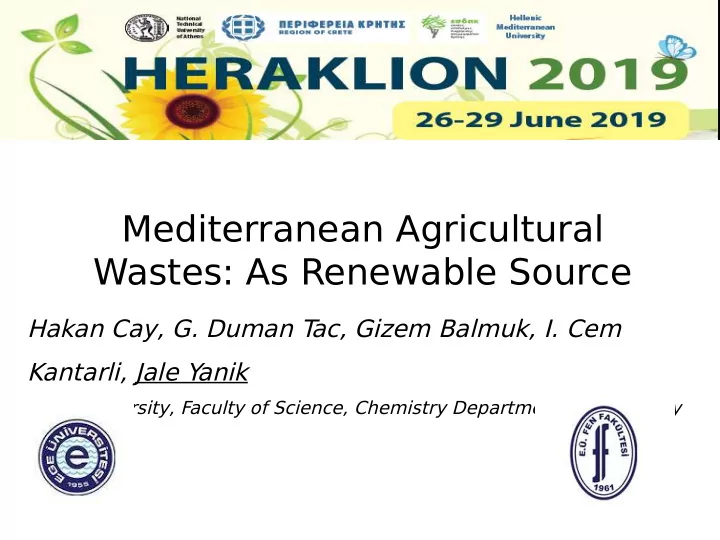

Mediterranean Agricultural Wastes: As Renewable Source Hakan Cay, G. Duman T ac, Gizem Balmuk, I. Cem Kantarli, Jale Yanik Ege University, Faculty of Science, Chemistry Department, Izmir,T urkey
PRESENTATION OUTLINE General Knowledge Materials and Methods Results Conclusion
INTRODUCTION WHAT IS BIOCHAR ? Solid product from thermochemical processing of biomass
WHAT IS BIOCHAR?
INTRODUCTION Dry and Wet Carbonization Dry Carbonization (Pyrolysis) Wet Carbonization (Hydrothermal Carbonization) 5
INTRODUCTION Hydrothermal Carbonization (HTC) converts wet biomass into biochar (hydrochar) Water- biomass suspension 180-250 °C Autogeneous pressure 6
Aim The management of pruning residues from olive tree and vineyards via biochar production Specifjc objectives - to optimize of both DC and WC conditions depending on mass yield energy densification ( HHV of biochar /HHV of biomass ) - to compare the combustion and gasification characteristics of raw biomasses with their biochars 7
MATERIAL-METHOD wt %, (db) wt %, (db) Vineyard Olive tree ash 2.4 C 47.1 ash 5.5 C 49.9 pruning 4 8 pruning VM 71.2 H 6.46 VM 67.9 H 6.45 FC 31.9 N 0.95 FC 26.6 N 1.88 HHV, MJ/kg : S 0.20 HHV, MJ/kg : S 0.15 24.75 24.75 Pyrolysis(DC) Hydrothermal Carbonization-WC -Initial N 2 pressure of 1 MPa --Temperatures: 250-500 °C -Temperatures: 200-260 °C - Duration: 60 and 120 min. - Duration: 0-240 min. - N 2 flow rate: 25 mL/min - water:biomass: 5:1 8
MATERIAL-METHOD CO 2 , CO, Bio-oil /Aqueous CHs, H 2 solution Biochar t s u b m o C n o i
RESUL TS- DRY CARBONIZATION Vineyard pruning Olive pruning Vineyard pruning
RESUL TS-WET CARBONIZATION Vineyard pruning Olive pruning 1,5 0 15 30 60 120 240 1,45 1,4 Energy Densifjcation 1,35 1,3 1,25 1,2 1,15 1,1 1,05 1 200 220 240 260
RESUL TS
RESUL TS Olive pruning Vineyard pruning
RESUL TS OPR 41 % yield 26.5 MJ/kg VY DC 37 % yield 28.4 MJ/kg 350 ° C, 60 min Like bituminous coal WC OPR 56 % yield 25.9 MJ/kg VY 56 % yield 23.9 MJ/kg 220 ° C, 60 min Like lignite
RESUL TS - Steam Gasifjcation H 2 Yields OTP OTP-WC OTP-DC VY VY-WC VP-DC Ash, % 5.9 6.33 11.9 2.3 1 7.9 C, % 57.16 60.9 64.4 47.14 59.22 72.4
RESUL TS - Combustion Reactivity, Ignition T . Burnout (% min -1 K - °C, T . °C 1 ) VY 250 478 1.36 VY -WC 288 517 1.82 VY -DC 357 507 1.18 OPR 234 490 1.04 OPR-WC 278 535 1.17 OPR-DC 326 487 1.85 Lignite 359 649 0.84
CONCLUSION According to Van Krevelen Diagram, most of biochars produced by DC were in the similar range of bituminous coal, while biochars obtained by WC showed a lignite-like structure. Biochars had higher ignition temperature than raw biomasses. The reactivity of biochars were found to be higher than that of lignite. The efgect of carbonization process type on As conclusion, the results obtained in this study combustion showed that dry carbonization of pruning wastes reactivity varied depending on the biomass type. appears to be promising process to provide benefjts to energy sector as well as to protect environment.
Thank you for listening ! Acknowledgement The fjnancial supports from TUBITAK (Project Contract No: 117M570) under the Eranet-Med2 Programme (Project Acronym: MEDWASTE) of the EU are gratefully acknowledged.
Thank you for listening !
Recommend
More recommend